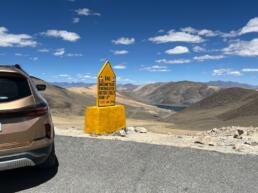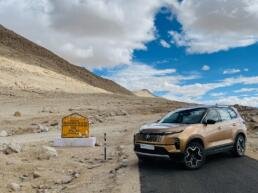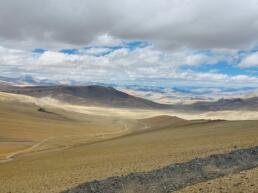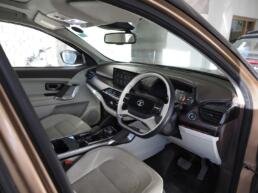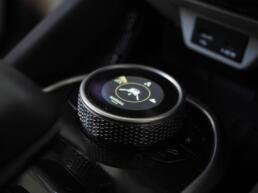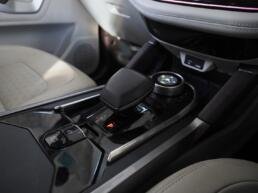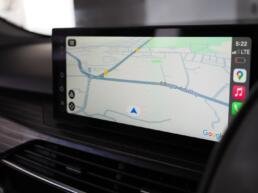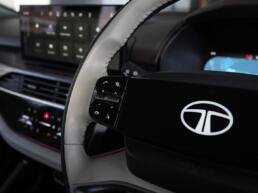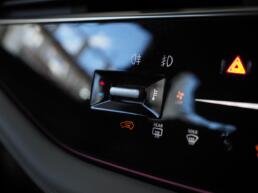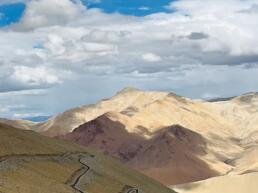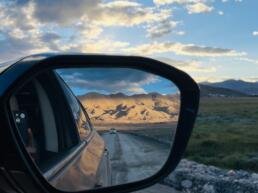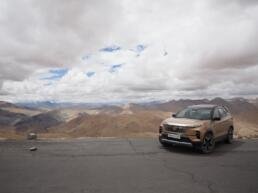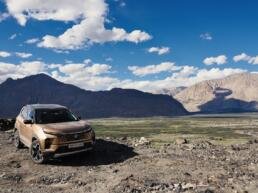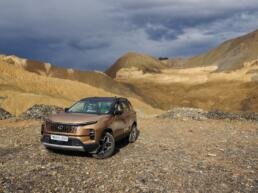The Tata Safari has always been the flagship in Tata’s stable. This is the “IT” car. The sign that you’ve made it in life. It’s also long been revered by auto-enthusiasts for its sheer ability. The new version has grown up considerably, added tonnes of kit, and the promise of a more wholesome lifestyle experience. Surely, the best way to experience it all is on a 2000km, 14 day trip within Ladakh. So that’s what I did!

I’ve just landed in Leh. It’s the middle of August and Leh has been unusually hot this year. Just 2 weeks ago, there was news about flights being canceled that set off some bouts of anxiety in my head. This trip has been in the works for a long time – years to be precise – and I was worried global warming would rain on this parade. But I’m here. It’s still ridiculously hot, and the sun is beaming down. The weather app on my iPhone says it’s 22 degrees, but the intensity of the sun is not something the weather app has a handle on. I’ve been waiting for about 15min now, and then I see it. The copper gold silhouette of a brand new Tata Safari in the distance.

This is the top of the line Accomplished Plus variant with all the bells and whistles. And at first sight, it looks impressive.
There’s a certain sleekness to it. It hides it’s dimensions rather well. Make no mistake, this is a BIG car. There’s 3 full rows of seats including a 3rd row that’s actually fairly good to use. But it’s packaged in a way that hides its bulk. The front fascia is all new. It’s less fussy than the previous generation, and looks more neatly integrated. There are backward swept daytime running lights and a body coloured grill interspersed with glossy black plastic. There’s a LandRover style bonnet, and neatly integrated LED headlamps at the bottom. There’s also Safari branding on the sides, as well as at the bock, under the Tata logo. It’s well done, without feeling excessive. There’s a certain attention to detail that you would expect from a car of this class and at this price point. As far as the design goes, I have no complaints. This is a striking, sleek looking car that grabs eye balls. It looks modern, and stands out amongst the competition.
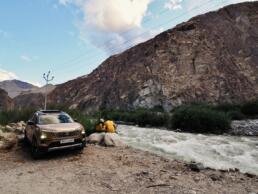
Speaking of price points, the Safari has unlevelled on this front as well. Prices start at about ₹16L for the base variants, and go all the way to ₹27L. That’s a wide spread considering there is just 1 engine option on offer. In true Tata fashion, there are 5000 variants to choose from. It’s all confusing, which I guess, is the point. My guess is that the car you would buy for ₹16L would offer a significantly different proposition as compared to the ₹27L variant I’m driving here. I would imagine that the proposition would be different enough that they feel like two different cars.
I pick up the keys to the Tata Safari. As is the case with new cars, I’m a bit tentative. Trying to figure out where the outer edges of the car are. What we have here is a 2.0L Kyrotec engine that developed a healthy 168BHP of power and an impressive 350Nm of torque. It’s mated to a 6 speed torque converter automatic transmission.
“
There is just 1 engine option on offer. There is no petrol option yet, and there is no EV yet either. Both of these options are in the pipeline, with the EV slated to launch sometime this year.
“
As I drive out of the airport, I’m made aware that this is a diesel. The windows are down, and I can hear a consistent thrum breaking the silence of the valley.I’d probably notice it a bit lesser in the city. But it’s definitely more noticeable here.
Over the next 14 days, I drive this car within Leh, on flat roads, on highways, on broken tarmac and on the world’s highest motor able road. So yes, steep slopes too. The only time I found the engine and gearbox combo a bit lacking was while attempting to make a quick overtake on the highway, once. In comfort mode, you go for an overtake, step on the throttle, the power comes in but then fizzles out quite quickly. Flattens out fairly quickly. Switching to Sports mode, or using the paddle shifters improves the power delivery and control considerably. Apart from that one overtake, I never found the engine to be lacking. Climbing Umlingla, going past 19000ft (higher than the Everest base camp), it always felt able and felt like it had more in store to deliver on the power front. When driven calmly, it inspires confidence and control. It’s refined, and there’s a sense of composure.
On our 4th day in Ladakh, I was in Nubra Valley, and decided to sample the Safari’s off-road abilities on a rocky, gravely path next one of the rivulets flowing into the Nubra river. The Safari is of course a 2WD powering the front wheels. This top of the line version comes with 19in wheels that look like they can take on some light off roading with ease. And that’s exactly what it felt like on that off-road trail. I also drove offroad and on dusty patches while driving toward Nerbula pass on the way to Umlingla. At no point did I feel the tyres, suspension or chassis were compromised. Tata offers 3 drive modes – wet, sand and normal. I was in normal throughout, and I was comfortable with the levels of grip on offer.
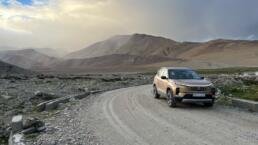
But you must keep in mind that this isn’t an off-roader. It’s testament to the progress made in engineering over the last 3 decades that front wheel drives can do as much as the Safari can. 99% of people who but this car will never need more. But to test for the last 1%, I did drive this off road on the banks of Tso Moriri lake, in the shadow of Mount Gaya. It didn’t end well. While the Safari can take dusty, rocky tracks and light off-roading – the sands on the bank of Tso Moriri are loose, deeps and sink in. Twenty seconds into that drive off-road, I had my 30% of my tyres in the sand. It took an hour and a half and help from 5 kind souls to escape that situation. The Safari is no Thar or Jimny replacement. But I don’t think it means to be, and that’s fine.
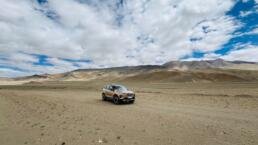
What it is absolutely wonderful at is being a lifestyle vehicle. The interior is all new, and class leading. There’s a free standing 12 inch touch screen to control every function the car offers – drive modes, JBL modes, Apple CarPlay, Android Auto, maps, ADAS and more. It’s a high quality screen. Touch input is slick and smartphone like. I’m sure it’s a capacitative touch screen. Brightness and resolution are class leading as well. So are the reversing camera and 360 degree camera feeds. This is a high quality infotainment system. You can see Tata was looking at future proofing this car in terms of tech and infotainment and it shows. I know cars that are one or two segments higher that have a worse infotainment experience. In that sense, the Safari exudes a very premium feel. The driver’s information display is great too. It’s crisp and high resolution. While I personally prefer dials, I like the fast that it can display maps on the driver’s info display too. Unfortunately, you can only beam Apple Maps from an iPhone and Google maps from Android. As an iPhone user, I saw myself using the central screen for mapping with Google maps. The quality of the switch gear on the inside was great, so were the stalks, gear selector (though slightly slow) and buttons on the centre console.
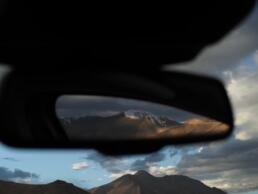
Talking about buttons, I can’t understand why Tata would do away with physical buttons on the centre console. There’s now instead a gloss black panel with such sensitive buttons for AC controls, locking and unlocking doors, boot opening and more. They look just fine, but they’re a nightmare to use on the go. You’re constantly fidgeting to find the right button, and get your press just right. But that’ say only qualm with the interior. Leave that aside, and this interior is class leading. The seats are comfortable, both in the front and in the 2nd row. There’s every creature comfort you can imagine – ventilated seats, leatherette upholstery, arm rests, soft touch materials everywhere your hand goes, and wood panels to break the monotony. There are sun blind for the rear windows, and the captains seats version also gets airline style headrests that can support your neck and head if you’re taking a nap in the back.
The airiness and view out of the cabin is impressive too. Fourteen days in Ladakh and this was a fantastic car to see the view out of. The cabin was airy, and the sunroof increased the sense of space within the cabin too. The panoramic sunroof by the way, is fantastic. I think there’s UV cut glass for the sunroof and the windshield and windows. I think it blocks out the heat admirably well on the sunroof. With the sun shade in place, I never felt like the cabin was warm because of the sunroof. UV cut glass is one of those understated features that makes all the difference in a country like ours, especially in Ladakh – where the sun is extra intense.

But once the sun went down, the panoramic roof was a pure delight. Watching the Milky Way, from the comfort of your captain’s seats. Pure joy!
What was pleasant was also the way this car rides. There is a certain poise to it, that is reminiscent of cars that are a couple of classes higher. Ladakh has its way of unsettling cars, but the Safari just took everything I threw at it with a sense of stability and class. Tata’s ride quality is something to take note – across its cars – and the Safari does not disappoint on this front. Khardungla, Nerbula, Photila, Changla, Kaksangla and the might Umlingla – the Tata Safari just took them all in its stride – conquering the highest of motor able roads in the world with ease.
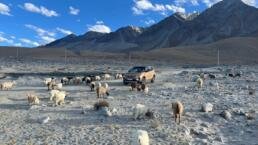
So what did 14 days with the Safari teach me? I think I’m blown away by the strides that Tata Motors has taken with this car. It’s several notches higher in terms of comfort and ride and experience than the Safari from a decade ago. It’s also strides ahead of the outgoing Safari in the way it makes you feel inside the cabin. Sure, it’s not a 4WD – but you won’t need that 99% of times. This Safari is an Urban legend, in the way the previous one was an off-roading one. And that’s not something to shy away from – it’s something to celebrate.


